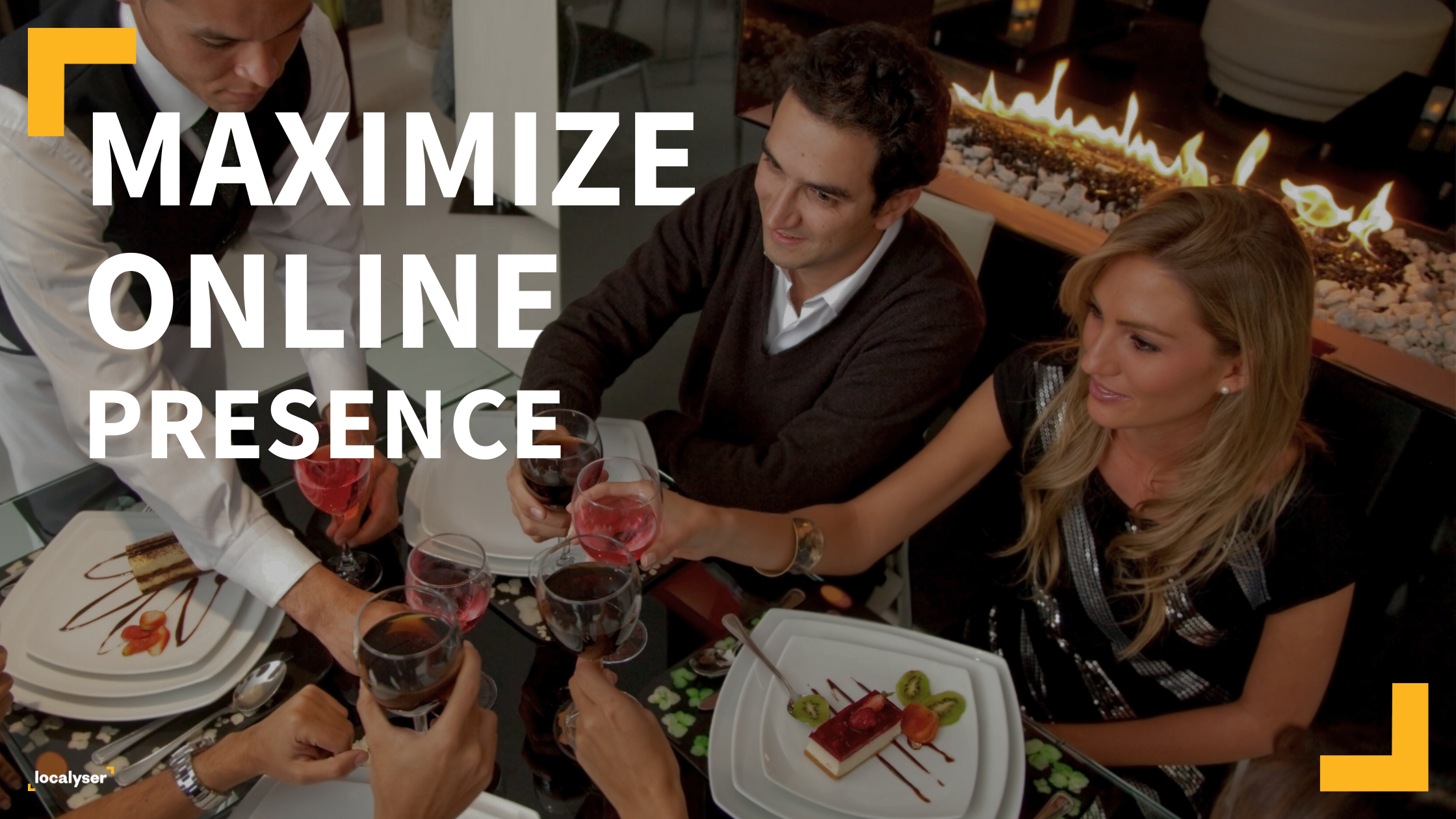
In today’s restaurant landscape, a strong online presence is no longer optional—it’s essential for driving foot traffic, retaining customers, and staying ahead of the competition. From optimizing your Google Business Profile and website SEO to leveraging social media, email marketing, and digital advertising, every digital touchpoint plays a role in shaping your brand and attracting diners. This blog explores how tools like Localyser can enhance customer engagement, improve efficiency, and boost visibility. By combining professional visuals, personalized communication, and emerging technologies like AI, restaurants can create a cohesive, omnichannel experience that builds loyalty and drives long-term growth.
In today’s digital-first world, a strong online presence isn't just beneficial, it’s essential. Especially in the restaurant industry where so much of your cliental is based on the online referrals of previous diners. When you receive one negative review, that can cost you several dozen potential customers, and the reverse is equally true. The more positive reviews you receive, the better. Now, in case you don't believe me, take a look for yourself:
SEO is the process of improving your website’s visibility in search engine results like Google. Effective SEO begins with strategic keyword research. This process involves identifying the words and phrases your target audience is using when searching for products, services, or information related to your business. Tools like SEMrush and Ahrefs can help you uncover high-volume, low-competition keywords that offer the best opportunity for ranking. By aligning your content with these search terms, you improve your chances of appearing in relevant search results, driving more qualified traffic to your site.
On-page SEO is an essential marketing strategy in the restaurant industry that involves optimizing individual web pages to achieve higher search engine rankings and attract more relevant traffic. As part of effective marketing strategies, key elements include using appropriate title tags, meta descriptions, and header tags (H1, H2, etc.), alongside crafting user-friendly URL structures. The content should cater to the customer base by being well-written and keyword-optimized, ensuring it is structured for easy readability. Enhancing your online reputation involves optimizing images, boosting page load speed, and ensuring mobile responsiveness, as these technical considerations significantly improve user experience and overall SEO performance. Integrating Google Business into your strategy can further enhance visibility by presenting essential business information, thereby engaging prospective customers more effectively.
Backlinks, which are links from other websites directing to your content, play a crucial role in enhancing online visibility and improving your search rankings on platforms like Google. However, the quality of these backlinks is key; links from authoritative and relevant sites can significantly boost your site's credibility and domain authority. To incorporate backlinks into your marketing strategy, focus on methods such as guest blogging, leveraging digital PR, forming strategic partnerships, and developing shareable content like infographics or original research. By executing these marketing campaigns effectively, you can earn more credible backlinks, boosting your online presence and helping your pages rank higher in search results.
Start by claiming and verifying your Google Business Profile to ensure your restaurant stands out in a competitive market. This crucial step allows you to take control of how your restaurant appears in search results, offering valuable insights into customer interactions. By verifying your profile, you unlock essential features such as responding to reviews, posting updates, and tracking business insights. Without verification, your listing may remain incomplete or could be managed by others, potentially hindering your online presence.
Ensure your operating hours, menu items, contact details, and location are consistently updated—particularly during holidays or changes in seasons. Incorporate high-quality photos of your signature dishes, team, and dining experiences to create a compelling first impression. Google favors active listings, so regular updates, such as details about special events or changes to dining options, enhance your digital presence and boost your online visibility.
Online reviews significantly influence your online reputation and local SEO. Encourage satisfied customers to leave feedback and consistently engage by responding, whether to positive feedback or criticisms, is a great way to foster trust and a positive brand identity. This practice not only demonstrates to Google but also to potential customers that your restaurant is active and attentive, thus establishing a strong presence digitally. Utilizing tools such as Localyser can help simplify this process by putting all of your reviews across all platforms on one dash board, to make managing your reviews easier and less time consuming.
Your website should include your menu, hours, contact details, location, and online ordering or reservation capabilities. Clear calls-to-action (CTAs), social media links, and an FAQ section can also improve user experience and conversion rates.
High-quality images of your food items are essential for digital marketing. While you may not be able to always get the highest quality pics for daily specials, you should be using high end photography for all of your digital menus and social media presence. They not only highlight your popular dishes but also enhance the experience of customers by drawing them towards your dining options. Well-captured visuals can significantly increase engagement across your website, Google profile, and social media presence. To achieve this, consider hiring a food photographer, or utilize good lighting and editing tools to beautifully showcase your menu items, dining options and service quality.
Integrating an efficient online ordering system can significantly boost sales. Choose platforms that offer seamless menu browsing, secure payments, and convenient order tracking. Keeping online ordering capabilities on your site rather than relying on third-party apps helps retain traffic. Additionally, utilizing various marketing channels, such as social media and email marketing, can promote your online ordering system. Engage customers through promotional offers and showcase special menu items to entice them to place orders directly. Conducting customer surveys can also provide valuable insights into improving the online ordering experience and enhancing overall customer satisfaction.
Not all social media platforms are equally effective for every restaurant. Instagram and TikTok are particularly powerful for showcasing high-quality food photography and driving engagement, thanks to their visual nature. Facebook, on the other hand, offers advantages for event promotions and fostering a sense of community. Selecting the right platform is essential for delivering targeted marketing messages that resonate with your audience. Incorporating influencer marketing can further expand your reach, as influencers can effectively draw attention to your offerings by sharing their experiences with your brand. Additionally, leveraging food blogs and digital advertising can supplement your social media efforts, enhancing your online presence across multiple channels. Be strategic in choosing platforms based on where your audience spends most of their time and tailor your content to fit the strengths of each channel.
Develop a diverse range of content, including behind-the-scenes videos, staff spotlights, customer testimonials, and tantalizing food highlights, to elevate your social media presence. Incorporate modern restaurant marketing techniques like influencer marketing to reach a broader audience across various social media platforms. Enhance engagement with your audience by utilizing interactive elements such as polls, contests, and live videos. Encourage and highlight positive customer reviews as part of your strategy to maintain content that is both fresh and interactive.
Consistency in your tone, visuals, and messaging across platforms is crucial for building a memorable brand that resonates with customer preferences. Define your brand's voice and consistently apply it to all your social media captions, email marketing campaigns, and customer interactions. This consistency not only helps attract potential customers but also ensures your brand stands out in a crowded market.
Craft email marketing campaigns that cater to restaurant owners by focusing on special events, holidays, and exclusive offers tailored to your customer base. Utilize compelling subject lines, engaging visuals, and straightforward CTAs to enhance open and click-through rates, ensuring your digital marketing efforts reach their full potential. Integrating digital menus into these campaigns can further streamline the customer experience across various marketing channels.
Segment your email list to deliver targeted digital marketing content, such as special offers for birthdays or promotions specific to certain locations. This approach to email marketing not only boosts engagement but also enhances customer loyalty by making your customer base feel appreciated and valued.
Utilizing social media, such as Facebook and Instagram, for advertising enables you to make informed decisions about promoting menu items directly to your target audience, such as offering dinner specials during peak hours. By incorporating A/B testing on your creatives and using high-quality visuals, you can enhance the customer experience and refine your social media marketing strategy through performance metrics.
Utilize Google Ads to elevate your restaurant to the top of search results when your target audience searches for relevant terms, such as “best sushi near me.” Incorporating location extensions, call buttons, and structured snippets can enhance the effectiveness of your ads. These features provide key insights into your customer base, allowing for more targeted and efficient social media marketing.
AI can help personalize customer experiences, automate responses, predict demand, and optimize marketing campaigns. For example, AI tools can respond to reviews, send targeted emails, or analyze customer behavior in real-time.
In the restaurant industry, today’s digitally-savvy customers frequently transition between websites, apps, social media platforms, and physical dining locations. Establishing a seamless omnichannel experience—where your restaurant's branding, service, and communication remain consistent across all digital marketing touchpoints—can enhance the overall customer journey. By doing so, you not only solidify your marketing strategy but also foster a robust customer base and increase customer loyalty. This approach allows you to effectively engage with your audience, ensuring they receive consistent messaging and promotions, such as special offers, no matter where they interact with your brand.
In an increasingly digital world, your restaurant’s success hinges on how well you manage and project your online presence. From SEO and review management to social media strategy and embracing new technologies, each element works together to shape the way customers discover, engage with, and return to your business. By investing time and resources into building a thoughtful, consistent digital presence, you're not only staying competitive—you’re setting the foundation for lasting customer relationships and sustainable growth. Now’s the time to take control of your online identity and turn digital interactions into real-world results.
 Local SEO Best PracticesWhy is a Store Locator Important for Your Business: How to Optimize Local Customer Retention
Local SEO Best PracticesWhy is a Store Locator Important for Your Business: How to Optimize Local Customer RetentionA store locator is a powerful tool that connects your online presence with physical locations, improving customer experience, increasing foot traffic, and boosting local SEO. This article explores how a well-designed, feature-rich store locator can drive sales, strengthen brand trust, and provide valuable insights for long-term retail growth.
 Online Reputation ManagementSocial Media Crisis Management: How to Turn a Bad Situation into Positive Growth
Online Reputation ManagementSocial Media Crisis Management: How to Turn a Bad Situation into Positive GrowthThis blog presents best practices for managing social media crises and negative reviews to protect brand reputation and build customer trust.
.png) Online Reputation ManagementBest Ways to Collect Customer Feedback in Canada: Your Guide for Improving Your Restaurant
Online Reputation ManagementBest Ways to Collect Customer Feedback in Canada: Your Guide for Improving Your RestaurantCustomer feedback is essential for restaurants to understand guest preferences, improve service, and stay competitive in Canada’s evolving culinary landscape. By using a variety of feedback methods—from online surveys and comment cards to in-person interviews and loyalty programs—restaurants can gather valuable insights that drive continuous improvement, foster loyalty, and enhance the overall dining experience.